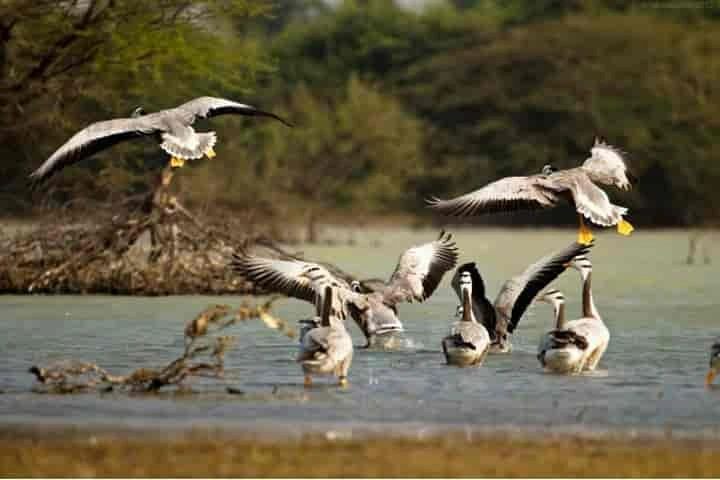India has now equalled China's record in protecting wetlands after the Union Ministry for Environment, Forest and Climate Change added 10 more to what is called the Ramsar list of sites.
These 10 sites include six in Tamil Nadu; one each in Goa, Karnataka, Madhya Pradesh and Odisha. With this the number of “wetlands of international importance” in India becomes 64 equalling China’s total. The total area covered by all these sites is 12,50,361 hectares.
Ramsar Convention or the Convention on Wetlands, is an intergovernmental treaty for the conservation of wetlands which was established in 1971 by UNESCO and came into force in 1975. It provides for national action and international cooperation on the issue of wetland and wise sustainable use of their resources.
Tamil Nadu
Sites in Tamil Nadu are Koonthankulam Bird Sanctuary, Gulf of Mannar Marine Biosphere Reserve, Vembannur Wetland Complex, Vellode Bird Sanctuary, Vedanthangal Bird Sanctuary, and Udhayamarthandapuram Bird Sanctuary making the total number as 10.
(PIc. Courtesy Twitter/@HemaShares)
A man-made wetland Koonthankulam Bird Sanctuary is located in Nanguneri taluk of Tirunelveli district. It is the largest reserve for breeding resident and migratory water birds in South India and forms a vital part of the Central Asian Flyway.
(Pic. Courtesy Twitter/@IndiaBespoke)
Gulf of Mannar Biosphere Reserve is located in the south eastern coastline of India, and boasts unique marine environment rich in biodiversity. One of the most biologically diverse regions in India, the Reserve has corals, fishes, sea turtles, crabs, lobsters, sea grasses, marine algae, birds, crustaceans, sponges, molluscs, sea horses, sea snakes besides mangroves. It is home to important and highly threatened species like the Dugong, whale shark, sea horses, Balanoglossus, green sea turtle, Hawksbill turtle, dolphins and sacred chanks.
(Pic. Courtesy Twitter/@kanyakumarians)
A human-made inland tank, Vembannur Wetland Complex forms the southernmost tip of peninsular India and has 250 species of birds. It is believed to have been constructed in the regime of Pandyan king Veeranarayana.
(Pic. Courtesy Twitter/@chandhini97)
Vellode Bird Sanctury is located in Vadamugam Vellode village in Erode district. This wetland has been evaluated and prioritized considering factors like the ecology of the wetland, earlier bird counts, records of breeding, and roosting colonies. This site forms part of the Central Asian Flyway.
(Pic. Courtesy Twitter/@Vishwamanoharan)
One of the oldest bird-protected areas, Vedanthangal Bird Sanctuary is located in Maduranthagam taluk of Chengalpattu district. The freshwater wetland is a people-protected water bird area, the history of which goes back to centuries where local people have been protecting this heronry and in return, have been benefited by the manure-rich water from the lake that increases the agriculture yield multi-fold.
(Pic. Courtesy Twitter/@_WildTrails)
Situated in Tiruvarur district the Udhayamarthandapuram Bird Sanctuary is in the Tiruthuraipoondi taluk and one of the important bird sanctuaries in Tamil Nadu. The notable species observed at the site include oriental darter, glossy ibis, grey Heron and Eurasian spoonbill. It is one of the important breeding sites for the darter and Eurasian spoonbill.
Odisha
Spread along the magnificent gorge over the Mahanadi river, this wildlife sanctuary was established in 1976 and supports a rich and diverse population of floral and faunal species. It is a mosaic of evergreen forests which play a vital role in the prevention of the gorge siltation and marshes. It is a habitat for the endangered gharial population.
(Pic. Courtesy Twitter/@CMO_Odisha)
With the inclusion of Satkosia Gorge, Odisha now has three sites.

(Pic. Courtesy Facebook)
Goa
The first site in the State, the Nanda Lake is considered to be critically significant for its ecosystem services and biodiversity values for the local communities and society at large. It is a habitat for notable faunal species including Black-headed ibis, Common kingfisher, Wire-tailed swallow, Bronze-winged jacana, Brahminykite, Intermediate egret, Red-wattled lapwing, Little cormorant and Lesser whistling duck.
(Pic. Courtesy Twitter/@CTRavi_BJP)
Karnataka
Ranganathittu Bird Sanctuary, Karnataka’s first site is located in Mandya district. Rich in biodiversity it is an ecologically important riverine wetland of India and rich in biodiversity, with several plant species, birds, fishes, frogs and butterflies. It supports several threatened creatures and plants and has healthy population of mugger crocodiles, smooth-coated otter and the endangered hump-backed masheer.

(Pic. Courtesy wikimedia commons)
Madhya Pradesh
Sirpur wetland is the third Ramsar site in Madhya Pradesh and supports a wide variety of flora and fauna. An important nesting place for terrestrial and aquatic migratory and residential birds it has diverse flora and fauna and provides ideal habitat in the form of food and shelter for a large number of migratory birds during the winter season.
Also read: Five wetlands in India declared Ramsar Sites




















